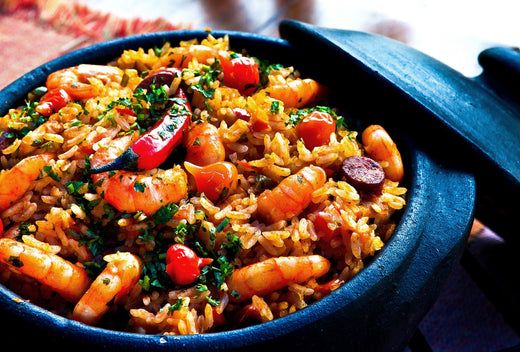
Table of Contents
Traditional Dishes in Spain: Spain is the biggest European maker of fish and vegetables. The assortment and freshness of the items are combined with the Spaniards’ ability and imagination. This results in a culinary tradition that is continually reestablished without giving up its roots.
Getting to know the conventional foods and nourishments of Spain goes far beyond tasting them. It is an amazing experience for each traveler who is serious one day to visit Spain. Here we introduce the top five traditional foods in Spain:
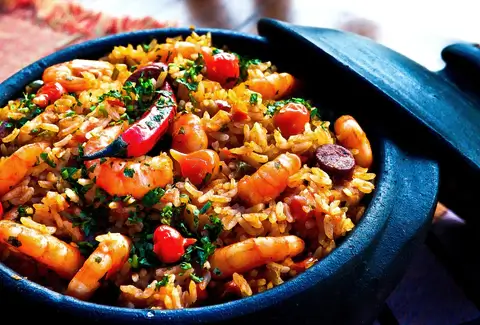
Paella is one of Spain’s most traditional foods. It is very simple to get ready. Also, it is made with rice and has numerous versions. The unique form is the Valencian Paella, with chicken and rabbit meats customarily made over a wood fire. But the recipe that has picked up popularity outside Spain is the Paella Marinera. It takes fish such as shrimp, octopus, squid, and mussels. It is prepared and served in a shallow, wide pan with a handle on each side called Paella. This is how it gives rise to the dish’s title.
Variations: Paella comes in various regional styles, reflecting the local ingredients available. For example:
Paella Valenciana: Features rabbit, chicken, and a combination of beans and artichokes.
Seafood Paella: Emphasizes a variety of fresh seafood, often excluding meat.
Mixed Paella: Combines both meat and seafood for a rich and diverse flavor profile.
Paella stands as a symbol of Spanish culinary expertise, showcasing the country’s rich agricultural and seafood resources. Its vibrant colors, aromatic flavors, and communal preparation make it an unforgettable culinary experience, embodying the warmth and conviviality of Spanish culture.
Learn More about Airfare Hacks: How to Get Cheap Flights Last Minute
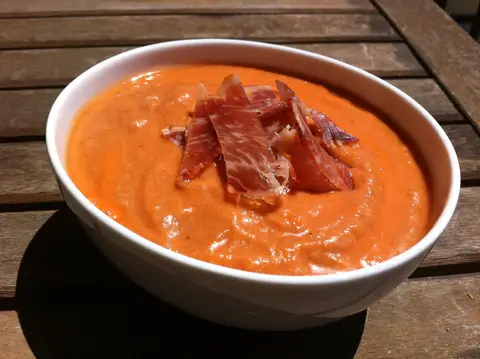
These are two tomato soups found in different districts of Spain and are exceptionally well known in Andalusia. These soups are served cold. Because of their softness and temperature, they are exceptionally prevalent in the summer. The distinction between them is that Salmorejo includes stale bread in its recipe and wraps it up with pieces of hard-boiled eggs and serrano ham. At the same time, Gazpacho includes a more fluid surface since it does not include bread and has more vegetable fixings like cucumber and peppers. So, it is also famous and one of the best traditional food in Spain.
Gazpacho is incredibly easy to prepare. The ingredients are typically blended together until smooth. The soup is then chilled before serving, allowing the flavors to meld and intensify. It’s often garnished with diced vegetables like cucumbers, bell peppers, and croutons before serving.
There are numerous regional variations of Gazpacho, with some including additional ingredients like almonds, grapes, or even watermelon. However, the basic idea of a cold, tomato-based soup remains consistent.
Salmorejo is typically served in bowls. It’s a more substantial dish than Gazpacho and can be enjoyed as a refreshing first course or even as a light main course, especially when accompanied by additional toppings like ham and eggs.
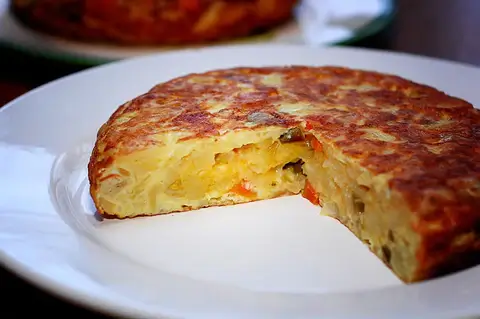
Another Spain traditional food is Tortilla. It is Spanish nourishment that is found in almost every corner of Spain. It is eaten anytime and anyplace, whether at domestic, in bars, or in eateries. The tortilla recipe is made with eggs and potatoes and takes after an omelet. The versions with fillings shift according to locale, the most common being cheese, ham, pepperoni, and sausage. Having known how it is made and the recipe of tortilla it is very famous in most parts of the country.
Sicily or Tuscany: Which Italian Destination Should You Choose?
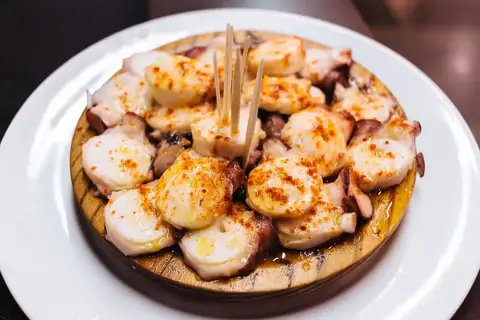
Polbo á Feira is a Spanish food with a tradition of more than 400 years. It is a traditional food mostly in Galicia but with roots within the territory of León. It is locally called Polbo á Feira. In this dish, the octopus is cooked entirely and served in little pieces, prepared with olive oil, paprika, and salt. Moreover, it is served on a wooden plate with bubbled potatoes. That is why it is one of the best traditional foods in Spain.
Polbo a Feira is often served with boiled potatoes, adding a starchy element to the dish. The potatoes are typically cut into small cubes and serve as a base for the octopus. This combination of octopus and potatoes creates a harmonious balance of flavors and textures.
Polbo a Feira is a dish meant to be shared, especially during festivals, fairs, and gatherings in Galicia. It is a popular choice at outdoor events and celebrations, reflecting the communal spirit of Galician cuisine.
Polbo a Feira is often paired with a glass of local white wine or Albariño. The crispness and acidity of the wine complement the richness of the octopus and the other flavors in the dish.
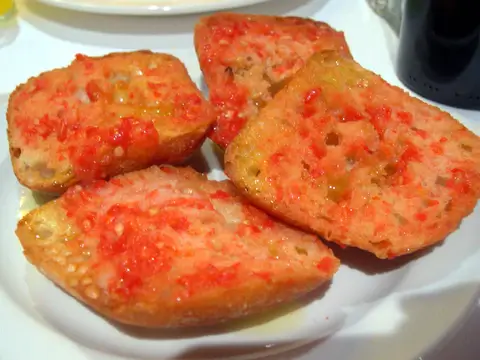
Pan con Tomate is a healthy and traditional food of Barcelona. It is also very easy to prepare. You only need a slice of bread, a tomato, garlic, olive oil, and salt. Within the Catalan adaptation, the garlic is rubbed on the bread; at that point, cut the tomato in half and rub it once more. Finally, you need to include olive oil and salt to taste. Lastly, the tomato is used to soften the bread from the day before.
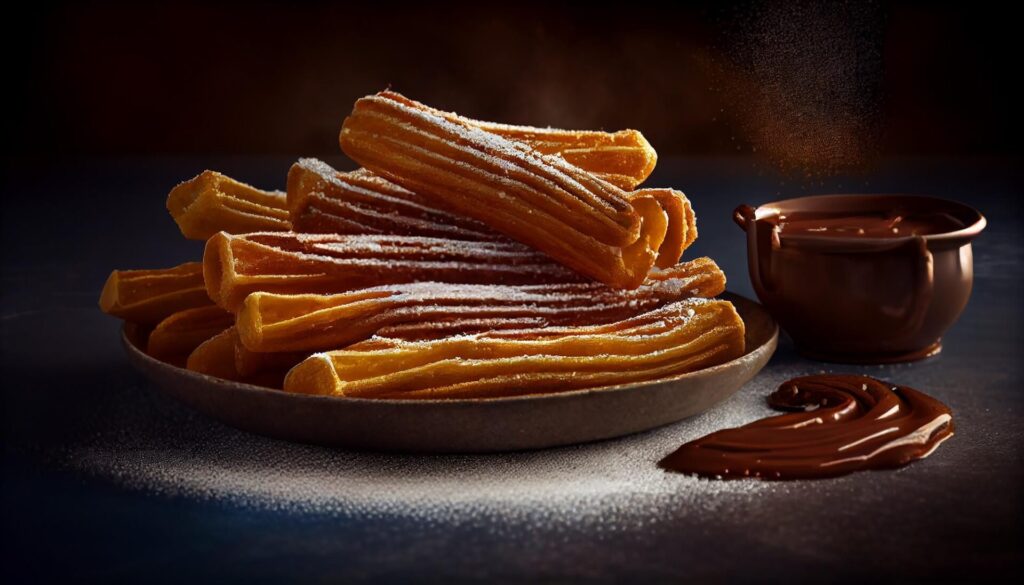
Churros are a beloved Spanish treat that has become popular worldwide. These deep-fried dough pastries are typically long and thin, with a ridged surface. The dough is made from a simple mixture of flour, water, and salt, resulting in a crispy exterior and a soft interior. Churros are often dusted with sugar immediately after frying, adding a sweet touch to their crunchy texture.
Churros con Chocolate is a popular choice for breakfast or as a mid-morning snack. It’s also enjoyed as an indulgent dessert. Here’s how to savor this delightful combination:
Ordering: When you go to a churrería (a place that specializes in churros), you’ll usually find Churros con Chocolate on the menu. You can order a serving of churros, which often comes in a portion of several churros.
Dipping: The best way to enjoy churros is by dipping them into the thick hot chocolate. The combination of the crispy churro with the velvety chocolate is a match made in heaven. The hot chocolate is so thick that it can almost be like a dipping sauce rather than a drink.
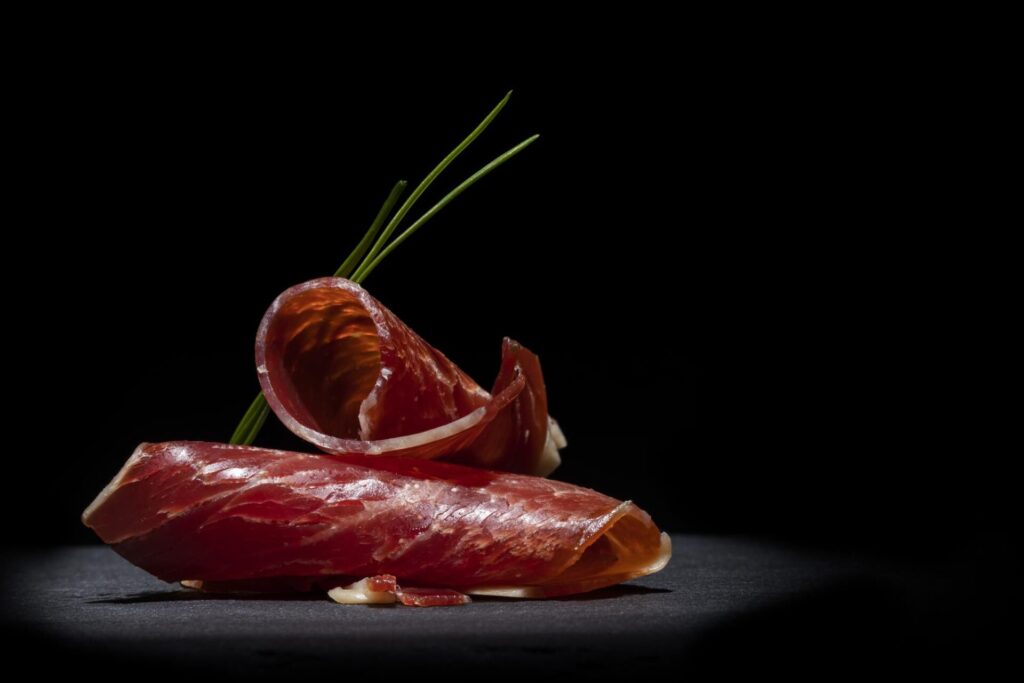
Spain’s reputation for exceptional cured ham is epitomized by Jamón Ibérico. This exquisite ham is crafted from the hind legs of black Iberian pigs, a breed native to the Iberian Peninsula. What sets Jamón Ibérico apart is the unique diet of these pigs, which includes acorns (bellota) during the final stage of their lives. This distinctive diet contributes to the ham’s unparalleled flavor and texture.
The production of Jamón Ibérico is a meticulous and time-intensive process. After the pigs are raised on a diet of acorns and other natural foods, they undergo a period of curing and aging that can last for years. The hams are salted and left to air-dry in a controlled environment. The final stage involves hanging the hams in cellars or natural caves, allowing them to undergo a slow, natural aging process.
How to Enjoy: Jamón Ibérico is typically served thinly sliced, allowing the exquisite flavors to be savored. It is often enjoyed on its own or accompanied by traditional Spanish bread or crackers. Some people pair it with a glass of wine, allowing the wine’s notes to complement the ham’s complexity.
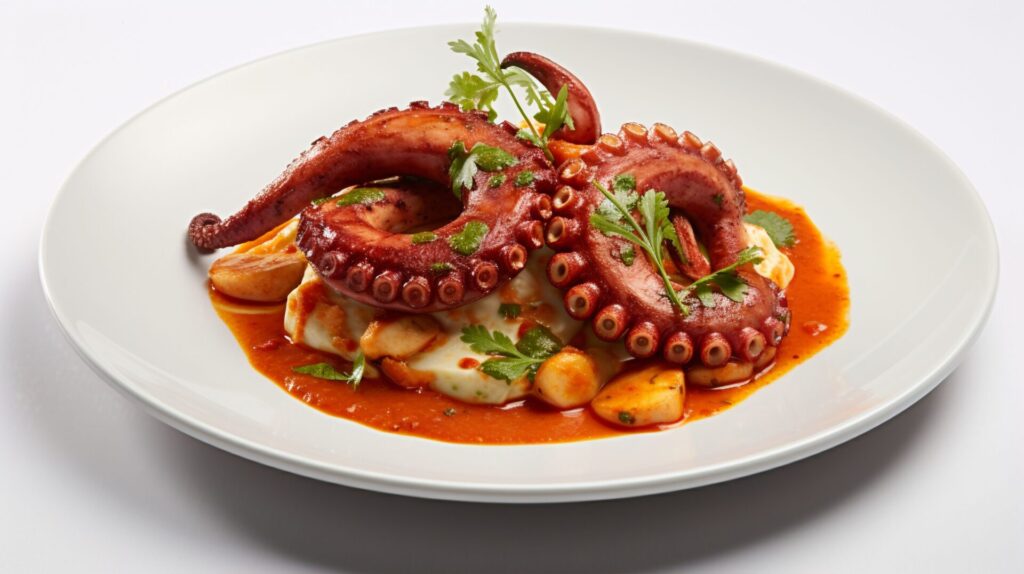
Pulpo a la Gallega, also known as Galician-style octopus, originates from the Galicia region in the northwest of Spain. Galicia, with its extensive coastline, has a rich maritime tradition, making seafood a central element of its culinary heritage.
The star of this dish is octopus, and the preparation highlights the unique flavors and texture of this seafood delicacy. Octopus is widely available in the waters off the Galician coast, contributing to the popularity of this particular culinary creation.
Presentation
Pulpo a la Gallega is often served on a wooden platter or rustic plate, allowing the vibrant colors of the dish to shine through. The octopus slices, glistening with olive oil and adorned with paprika, create an inviting and visually appealing presentation.
Accompaniments
While Pulpo a la Gallega can be enjoyed on its own, it is sometimes served with boiled potatoes or crusty bread, providing a delightful contrast in texture and flavor. The potatoes or bread can absorb the flavorful juices from the octopus and enhance the overall dining experience.
This dish pairs well with crisp white wines or the local Albariño, enhancing the dining experience with a refreshing complement to the rich and flavorful octopus.
Calamares a la Romana is a classic Spanish dish that showcases the culinary artistry of deep-frying squid rings to perfection. The dish is known for its simplicity, allowing the natural flavors and texture of the squid to shine through the light and crispy batter.
The main ingredient is squid, and the dish typically features the rings of the squid body. The squid is often cleaned and prepared, ensuring a tender and succulent final product. The batter is made from a simple mixture of flour, water, and sometimes a bit of salt and baking powder to achieve the desired lightness.
Calamares a la Romana is typically presented in a visually appealing manner. The golden-brown squid rings are often arranged on a plate, showcasing their inviting crispiness. The dish is sometimes garnished with a sprinkle of salt or a drizzle of lemon juice for an extra burst of flavor.
Accompaniments: Calamares a la Romana is commonly served with complementary accompaniments to enhance the overall experience. Two popular choices are:
Aioli: A garlic-infused mayonnaise-based sauce that adds a creamy and savory element to the dish.
Lemon Wedges: Squeezing fresh lemon over the fried squid rings provides a zesty and citrusy contrast, balancing the richness of the batter.
So, if you are a traveler and want to stay one day in Spain, we hope this article will be most helpful for you to find the best food. These are the top nine Traditional Dishes in Spain. But no matter where you go, always remember to Travel Till You Drop!


Hi, Jill Here
Hi! I’m Jill, a Dallas, Texas girl traveling the world. After a career in the Air Force and touring over 50 countries later, my need to explore keeps going! It’s time to rock & roll and find all those places I never knew I was missing.
Table of Contents
Join me to get exclusive travel tips, giveaways and more!
Gallery
Copyright © 2023 | All Right Reserved